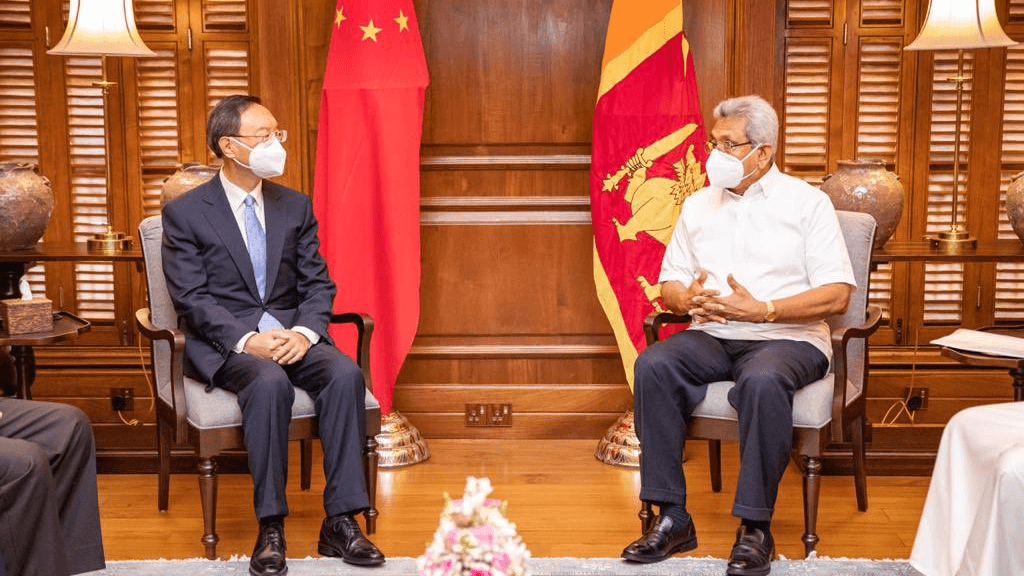On Friday, Sri Lankan President Gotabaya Rajapaksa said that he aims to achieve a “China-style development model for Sri Lanka” and applauded China’s development work in its rural areas. He pledged to discredit the ‘debt trap’ narrative hanging over Sri Lanka’s relationship with China.
Addressing the Hambantota port issue, he said that the port’s construction was Colombo’s decision in furtherance of its aim to uplift the standard of living in the country. “We were convinced that it would be a project with a vast potential for generating income and employment opportunities. China offered to fund it. Many geopolitical analysis interprets this project as a ‘debt trap’ set up by China to gain control over Sri Lankan affairs. I was to prove that this is not the case and that this large-scale project will help improve the living standards of the people,” he added.
Rajapaksa further celebrated Sri Lanka’s all-weather friendship with China, with special reference to Beijing’s assistance in ending the state’s 30-year long conflict with the Liberation Tigers of Tamil Eelan (LTTE). He said, “China extensively supported us to defeat terrorism. Bilateral relations reached a higher level following the end of the armed conflict.”
These comments closely follow Rajapaksa’s meeting with Yang Jiechi, a politburo member of the Chinese Communist Party. During the meeting, the two leaders discussed expediting the completion of the Hambantota Industrial Zone and the development projects in Colombo. They also discussed finalising a Free Trade Agreement, which the two sides previously agreed to in 2013. The deal had been halted after China disagreed to consider Sri Lanka’s request to review the agreement in ten years.
This meeting came as Sri Lanka prepares to receive the second instalment of China’s $1.2 billion loan. In March, Colombo received $500 million as the first tranche of the loan. Shortly after the meeting, China announced a $90 million grant to the island country for “medical care, education and water supplies in Sri Lanka’s rural areas.”
Rajapaksa was previously criticised for his engagement in China’s debt-trap during his 2010-2015 tenure. Currently, with a debt of over $50 billion, China’s total debt is about 90% of its GDP.
India was particularly concerned after Sri Lanka agreed to a 99-year lease of the Hambantota port in 2017, as it could plausibly be used to extend Chinese military presence in the region. This collaboration was not only worrying for India’s security concerns but also its trade interests, as the port is strategically located along an international shipping route.
In August, Sri Lankan Foreign Secretary Jayanth Colombage responded to India’s concern and clarified that the contract for the Hambantota port was first offered to India, but India rejected the offer. He reassured India that the port would only be used for commercial activities, and not for military purposes. He further highlighted that Sri Lanka plans to maintain a neutral position between the two, and will not allow “any particular country to use it as a staging area to do anything against another country – especially so India”.
Moreover, he also said that, in the future, the Sri Lankan government will not relinquish complete control over such “strategic national assets” and will ensure at least a 51% stake in any such projects with foreign entities. Sri Lanka, and countering Chinese influences on the island, is not only crucial for India, but also for its allies, Japan, the US and Australia, who are all looking to counter China’s aggression in the Indo-Pacific region.
Expect a “China-Style Development Model for Sri Lanka”, Says President Rajapaksa
President Rajapaksa met with a high delegation from China and discussed the construction of the Hambantota port and a bilateral free trade agreement.
October 12, 2020

SOURCE: TWITTER
